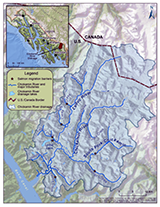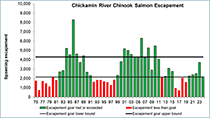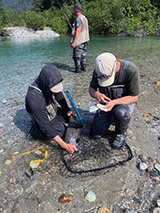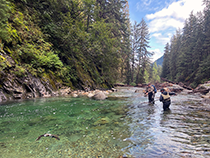Commercial Salmon Fisheries
Southeast Alaska & Yakutat Research: Chickamin River Chinook Salmon Research

Figure 1. — Click for more Info

Figure 2. — Click for more Info

Figure 3. — Click for more Info

Figure 4. — Click for more Info

Figure 5. — Click for more Info

Figure 6. — Click for more Info
Overview
The Chickamin River is a glacial system located approximately 71 km northeast of Ketchikan, Alaska that flows through Misty Fjords National Monument and empties into Behm Canal (Figure 1). The river and habitats are pristine and mostly unchanged by human development (Figure 2). Over the past few decades this river has supported runs of Chinook salmon averaging about 3,000 large Chinook salmon (essentially 28" and greater in length). After leaving the freshwater as juveniles, these fish primarily rear in or near Southeast Alaska and northern British Columbia and are primarily caught in marine sport and commercial fisheries. Data from this project are used to estimate adult abundance and adult age, sex, and length compositions.
Standardized observer counts using aerial surveys of large Chinook salmon spawning abundance have been performed by the Alaska Department of Fish and Game (ADF&G) annually since 1975 on the Chickamin River. Since these counts only represent a fraction of the overall total large spawning abundance, mark-recapture studies were performed in 1996 and 2001–2005 (Frost et al. 2024) to develop a factor to expand peak counts to estimates of large spawning fish. An escapement goal of 2,150 to 4,300 large fish was developed for this stock in 1997 (McPherson and Carlile 1997) based off observer counts.
Available harvest information on this stock from 2006–2009 suggests that about 33% of the fish are harvested annually in marine sport and commercial fisheries (Frost et al. 2024). For comparison, the nearby Unuk River stock had a lower harvest rate of 21% during these same years. The Chickamin River stock, like others in Alaska, has recently experienced a decline in productivity. From 1999 to 2015, the Chickamin River met or exceeded the lower bound of the escapement goal in all but one year. However, between 2016 and 2019, the Chickamin River missed the lower bound of the escapement goal four years in a row which led to its designation as a stock of concern in 2021 (Figure 3). Since this designation, management restrictions have increased, and although there are no coded wire tag (CWT) studies being conducted, it is presumed that the Chickamin River harvest rate has dropped similarly to the nearby Unuk River where CWT studies are ongoing. As a result, the lower bound of the escapement goal has been met 5 years in a row from 2020 to 2024. Chickamin River salmon research provides fishery managers the tools necessary to manage under the sustained yield principle, representing a prime example where detailed stock assessment information, coupled with responsive management, can achieve base level escapements even in the face of poor production.
Adult Spawning Abundance
Since 1975, total escapement, based on mark-recapture studies or expanded peak observer counts in years lacking mark-recapture, has ranged between 722 and 8,289 large fish, with an average of 3,006 large fish (Figure 3). In past mark-recapture studies, Chinook salmon were captured in the lower Chickamin River in June, July, and early August and marked and tagged as part of event 1 of the mark-recapture study. Fish were also sampled for age, sex, and length (ASL) information. In August and September, as part of event 2, fish were sampled for marks, tags, and ASL information in eight principal spawning areas.
In the absence of mark-recapture studies, abundance is estimated using expanded peak observer counts (Figure 4) and ASL (Figure 5) sampling takes place exclusively on the spawning grounds in August and September. All fish are checked for the presence of adipose fins, and fish missing adipose fins are sampled for the presence of a CWT which would have been applied to fish during their juvenile life stage (e.g. at the nearby Unuk River, hatcheries, etc.). All sampled fish are given a distinct mark to avoid resampling of any recaptured fish and subsequently released. Fish are sampled on the spawning grounds using rod and reel snagging gear (Figure 6) and dip nets and as carcasses, and since 2018 nearly 14% of the large Chinook salmon escapement has been physically handled and sampled.
These very high sampling rates are a tremendous feat leading to improved precision in various resulting analyses. In 2023 and 2024, a transgenerational genetic mark-recapture (tGMR) project is being conducted which will be used to further refine the expansion factor and provide a second estimate of adult abundance in 2023.
Project operational plans are published annually to outline project methods, results, and data analyses, and are available online. Information gathered from this work is published in the ADF&G Fishery Data Series and is complete through brood year 2005 and escapement and ASL through 2012. (PDF 5,814 kB).
Juvenile Abundance
There are no current studies being conducted to estimate juvenile abundance of Chinook salmon on the Chickamin River; however, studies were conducted from 1983 to 1988 and from 2001 to 2007. Juveniles from the same parent year were marked with adipose fin clips and tagged with CWTs as fingerlings (or "parr") during the fall (September and October), and again the following spring as smolt before they emigrated to sea in April and May. Tagging in the fall and spring greatly increased the total number of fish leaving the Chickamin River possessing a CWT. On average, 22,000 parr and 8,500 smolt were tagged each year and smolt abundance ranged from 170,013 to 413,660 with an average of 287,012 from the 2000 to 2005 parent years (Frost et al. 2024).
Juveniles were captured primarily using minnow traps baited with disinfected salmon eggs and trapping occurred exclusively in the mainstem and side sloughs of the lower river. After fish were captured, they were transported back to camp and anesthetized, marked, coded-wire-tagged, and held for 24 hours to assess retention of CWTs and ensured they were healthy prior to release back into the appropriate habitats.
Chickamin River Chinook salmon rear at sea from one to five years and information accumulates annually on these fish as returning adults are sampled for ASL information on the spawning grounds. Data collected from these returning adults combined with adult spawning abundance estimates help researchers estimate parent year production.
Selected Publications
Chickamin River Adult Spawning Abundance
- Escapements of Chinook salmon in Southeast Alaska and transboundary rivers in 2022 (PDF 1,280 kB)
- Estimation of age, sex, and length composition of Chinook salmon in the Chickamin, Keta, and King Salmon Rivers, and Andrew Creek, 2020-2021 (PDF 1,553 kB)
- Production of Chickamin River Chinook Salmon from the 2000-2005 Broods, Escapement from 2009-2012 (PDF 5,814 kB)
Chickamin River Juvenile Abundance
- Production of Chickamin River Chinook Salmon from the 2000-2005 Broods, Escapement from 2009-2012 (PDF 5,814 kB)
